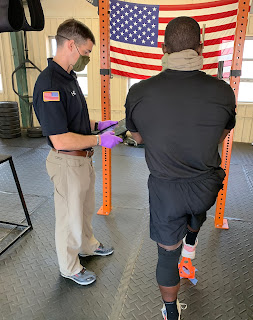MIRROR Project Tests Body-worn Sensor Technology Predictive of Musculoskeletal Injury
By Hadiyah Brendel
Nearly 800,000 service members experience a musculoskeletal injury (MSI) annually. Eighty-five percent of MSIs are non-combat related, such as those resulting from overuse during military training. The most common site of MSI is the knee, accounting for 40% of these injuries.
The Musculoskeletal Injury Rehabilitation Research for Operational Readiness (MIRROR) program advances rehabilitative care for MSIs by coordinating research projects between military treatment facilities and civilian organizations. MIRROR is headquartered at the Uniformed Services University (USU) within the Department of Physical Medicine and Rehabilitation, led by chair Dr. Paul Pasquina.
 |
| The single limb test is a long-time measurement of Region and Limb Stability (ROL) or static knee joint stability. (Photo credit: Dr. Ignacio Gaunaurd) |
CaseSenseTM is a body-worn sensor system used to assess risk of lower-extremity injury. The device, developed by the University of Miami, consists of two knee sleeves with two small sensors that rest above and below the knee. Participants in the study wear the knee sleeves while performing two tests: a single limb stance and a four-meter side step test. Linked via wireless technology, the device sends metrics to a portable device such as a tablet.
“We developed the sensor technology with the purpose of being able to quantify the quality of movement of athletes,” says Gaunaurd. He adds that previously, maybe a clinician identified an issue but was not able to quantify how at risk the individual was for overuse injury. Or, they weren’t able to quantify their readiness to return to activity.
The sensor technology of the CaseSenseTM measures the movement between the upper and lower leg. It also provides metrics on balance. “You get the single leg symmetry stance and balance. Then you also get the movement of side-to-side frontal plane movement,” says Goss.
“Asymmetry between the limbs,” where one limb’s balance or stance is greater than the other, “is predictive of previous injury,” Goss continues. The hypothesis is that individuals who have greater asymmetry between their limbs are at a greater risk for MSI than their counterparts.
Before gaining approval to screen the 82nd Airborne Division, Drs. Gailey and Gaunaurd conducted a study on Division 1 college athletes at the University of Miami. The results of that study demonstrated 92% validity for predicting injury.
“They were able to predict injury in the athletes that have 60% or less symmetry between sides,” says Goss.
At Fort Bragg, the MIRROR team asks for volunteers from the paratroopers as they begin their weeklong Airborne Integration Course. After they consent, the paratroopers answer questions about past injuries to their hips, knees, feet, or ankles. Then, they perform the movement tests. Altogether, the process takes about ten minutes.
“These types of tests give us insight on every day movement patterns performed by paratroopers during physical training and during combat operations, both critically important to not only enhance performance but also to potentially prevent injuries as well,” says Helton. The service members also give consent for MIRROR to follow their electronic medical records over the next year.
Following their medical records allows MIRROR to validate the results of the first study. Does greater limb asymmetry identify service members who, within the next year, will visit a clinician, physical therapist, or even have surgery because of a MSI? Goss says, “if [the study] demonstrates good validity in predicting injury, then the next step is to try to prevent those injuries”.
Preventive measures include what Gaunaurd calls a “prehab” program. The goal in the future, says Gaunaurd, is to “prevent [injury] with both potentially identifying it and then to develop a prehab program to train the tactical athlete. And, to improve that balance or agility impairment and place them at less of a risk for injury.” Service members whose outcome measures are in the red – 60% or less symmetry – would receive “a standardized, prescription-based exercise program to improve those impairments,” says Gaunaurd. They would then work with a physical therapist, or athletic trainer, on targeted exercises to bring the limbs closer to symmetry.
Instead of waiting for service members to show up in his office for treatment after they are injured, Helton says, “the intent of this is to turn that paradigm around.” Switching the focus from reliance on reactive measures and working, where possible, on preventive measures is the goal.
“I think we have an extreme need. There are millions of dollars the DoD is spending annually on lower-extremity injuries that can be prevented,” says Helton. “The people we are training, the people we are investing our time and money into, we owe it to them to give it our best. I think this [project] is an example of that.”
“The whole intent for us,” he continues, “is if we can find a reliable, accurate and fast and cost-effective way to predict these injuries before they occur. So our physical therapists, athletic trainers, and strength coaches can intervene quickly—so we can screen and intervene—that’s the whole intent.”
“Through this collaboration,” Helton concludes, “we’ll be able to close a massive need. I think these types of studies have the potential to help drive the next 10 to 20 years in the Army when it comes to injury prevention strategies.”





